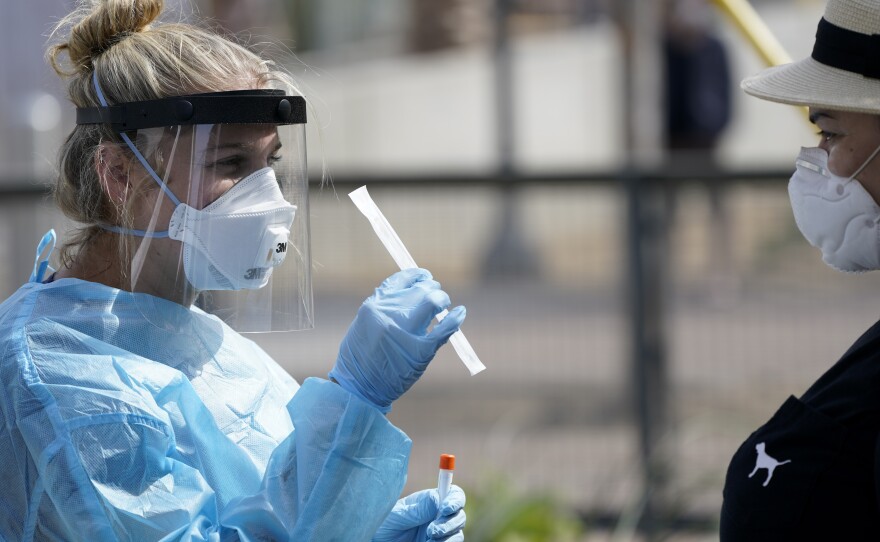San Diego County health officials reported another huge jump in COVID-19 cases — 833 — but no additional deaths Monday, marking an alarming surge in the disease's spread less than two weeks before Thanksgiving.
The county's three largest daily case counts since the pandemic began have all come in the past three days. The 833 cases reported Monday are the second most the county has announced in a day, following a record high of 1,087 reported Sunday and a then-record 736 on Saturday.
On Wednesday, a then-record 661 cases were reported in the county — surpassing the 652 cases reported Aug. 7. Another 620 cases were reported Thursday.
County Supervisor Nathan Fletcher said it was increasingly important to follow public health guidelines during the Thanksgiving holiday, when some may be tempted to host large gatherings with people they don't share a home with.
"It's not every Thanksgiving, it's just right now, it's just this time," Fletcher told KPBS Midday Edition on Monday. "Those are the decisions that everyone has to make around what can you do to slow the spread. And that is limiting contact with individuals who do not live with you on a regular basis."
San Diego County entered the most restrictive "purple tier" of reopening on Saturday, with venues such as restaurants, gyms and houses of worship ordered to operate outdoors only.
Some businesses have already said they will not follow those mandates. Fletcher said the county had sent cease-and-desist letters — the first step toward legally cracking down on a business's public health order violation — to 17 entities.
Fletcher said the county's ability to restrain violators depended on cooperation from local law enforcement agencies. El Cajon, he said, had "proudly proclaimed that they will not enforce any public health orders or hold anyone accountable for egregious or blatant violations."
El Cajon City Manager Graham Mitchell defended the city's actions and said Fletcher was "playing politics with COVID-19."
"We have a very busy (police) station so we've prioritized COVID complaints as low," Mitchell said. "We go out and talk to businesses, use education to secure compliance and we've been successful so far."
The most recent data show El Cajon has the highest coronavirus case rate of any city in San Diego County.
Dr. Wilma Wooten, the county's public health officer, said she understood people's frustration with the COVID-19 restrictions ramping up again. But she said the fastest way out of the pandemic is for everyone — individuals and businesses — to abide by the public health order.
"Remember that we aren't assigned a tier out of nowhere, we earn our tier placement," Wooten said. "You have a say in our tier placement — much more than the state, much more than Californians who live in other counties."
Amid the accelerating community spread of COVID-19, the San Diego County Sheriff's Department also announced Monday that 55 of 70 inmates in the 1C module of the George Bailey Detention Facility had tested positive for COVID-19.
"Fifteen tested negative, but are nevertheless being isolated and monitored due to their exposure," said sheriff's Lt. Ricardo Lopez. "At this time the outbreak is limited to one module, but is the most significant COVID- related event to date in our jail system."
"Our population has been stable near 4,000, however, consideration will be given to conducting additional releases if necessary as we continue to monitor our population and the COVID-19 pandemic," he said.
Gov. Gavin Newsom announced Monday that rising case rates and testing positivity rates were placing 28 more counties in the purple tier. He also said the additional restrictions would take effect within 24 hours, as opposed to the 72-hour grace period previously allowed for businesses to adjust.
"Every age group, every demographic — racial, ethnic — in every part of the state we are seeing case rates increase, and positivity rates increase as well," Newsom said Monday. "No longer concentrated in just a handful of counties, we are seeing community spread broadly now throughout the state of California."
Following Monday's tier adjustments, more than 94% of Californians will be living under the state's most restrictive guidelines.
Many nonessential businesses are now required to move to outdoor-only operations. These include restaurants, family entertainment centers, wineries, places of worship, movie theaters, museums, gyms, zoos, aquariums and cardrooms.
The restrictions include closing amusement parks. Bars, breweries and distilleries are able to remain open as long as they are able to operate outside and with food on the same ticket as alcohol.
Retail businesses and shopping centers can remain open with 25% of the building's capacity. No food courts will be permitted.
Schools are able to remain open for in-person learning if they are already in session. If a district has not reopened for in-person learning, it must remain remote only. Offices are restricted to remote work.
Remaining open are essential services, personal care services, barbershops, hair salons, outdoor playgrounds and recreational facilities.
The county's demotion from the less-restrictive red tier is the result of two weeks of case rates that exceeded the threshold of 7 per 100,000 residents.
In recent weeks, the region had an unadjusted rate well above the purple tier guidelines, but a significant effort to increase the volume of tests had allowed for an adjustment to bring it back to the red, or substantial, tier.
Of the total number of cases in the county, 4,212 — or 6.4% — have required hospitalization and 960 patients — or 1.5% of all cases — had to be admitted to an intensive care unit.










